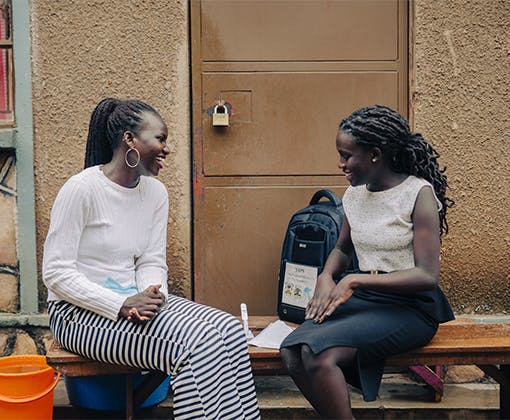If you're living with someone who has been diagnosed with HIV, whether this is a partner, friend, family member, or roommate, there are many things you can do to support their HIV journey.
Many people who are not living with HIV maintain close and intimate relationships with partners who are living with HIV. These relationships are sometimes called 'serodiscordant' or 'serodifferent.[1] With modern treatments and preventive measures, couples in serodiscordant relationships can enjoy long and fulfilling lives together.[1]
In a Positive Perspectives Survey:[2]
of people living with HIV looked to their partners for emotional support
relied on partners to help with medication reminders
wanted help and support in decisions around the topics they needed to discuss with their doctors
Receiving an HIV diagnosis can be challenging, but providing understanding, care, and patience is crucial to help people living with HIV navigate this significant life change.[3]
Michael provides advice on being the partner of someone living with HIV
In this video, Michael provides advice to other people living with an HIV-positive partner about making sure they are informed about HIV. Michael has been there for Mortiz, from the beginning of his HIV journey and they are planning for a long future together.
HIV AND SEXUAL ACTIVITIES
If you or your partner are living with HIV, you can still enjoy a sexual relationship. As HIV can be transmitted through unprotected sex, preventative measures should be taken by those in a serodiscordant relationship.
Different sexual activities can carry different levels of risk for HIV transmission:[11]
- Anal sex carries a higher risk of HIV transmission than other types of sex, with receptive anal sex (bottoming) being the highest risk.[11] Insertive anal sex (topping) also poses a risk, though it is lower.
- Vaginal sex has a lower risk of HIV transmission, but protection is still important.
- While the risk of contracting HIV through oral sex is extremely rare.
PrEP and PEP
People without HIV who are living with someone who is HIV-positive may want to consider preventive HIV medications to reduce the risk of acquiring HIV, especially if their partner has a detectable viral load
- PrEP (Pre-Exposure Prophylaxis) is a daily pill for people without HIV who are at high risk of acquiring the virus. It can reduce the likelihood of contracting HIV from sexual contact by up to 99% when taken consistently, making it an effective option for those in a relationship with an HIV-positive partner.[1,2,5]
- PEP (Post-Exposure Prophylaxis) is an emergency treatment taken within 72 hours after potential HIV exposure, such as unprotected sex with an HIV-positive partner, or encountering HIV-positive blood in your own bloodstream. It involves a 28-day course of HIV medications to prevent the virus from spreading in the body and is only for emergency use.[1,3,6]
Condoms
You should use condoms during sex, especially if the HIV-positive person has a detectable viral load. Condoms made from durable materials like latex are recommended; avoid natural materials, which do not protect against HIV. Correct condom use is also the key to preventing breaks or malfunctions.[7]
Lubrication
Lubricants can further reduce HIV risk by decreasing friction and preventing condom failure. Always choose water- or silicone-based lubricants with latex condoms, as oil-based lubricants can weaken latex.[7] Avoid spermicidal lubricants containing nonoxynol-9 (N-9), as they may cause irritation and increase the risk of HIV transmission.[1,4,7]
It's important to know that many common fears about living with someone with HIV are based on misconceptions.[15] HIV is only transmitted through specific bodily fluids from a person who has a detectable viral load. These fluids include blood, semen and pre-seminal fluid, vaginal fluids, rectal fluids, and breast milk.[16]
When considering how to live with someone with HIV, it’s crucial to understand that HIV is not spread through casual contact. This means it is completely safe to:[15]
- Be near someone when they sneeze or cough
- Hug, shake hands, or engage in other forms of casual touch
Only someone with a detectable viral load can transmit HIV through unprotected sex, sharing needles, or other direct contact with these fluids. Remember, U = U.[16]
Xiana and Patricia chat about Xiana’s journey with HIV
Listen to Xiana as she talks about her journey with HIV, including her relationship with Patricia. They discuss how Xiana was worried immediately after her diagnosis about sharing food and utensils with friends and families.
YOU MAY ALSO BE INTERESTED IN
It is now established that if you’re on treatment and have an undetectable viral load, you cannot pass on HIV through sex. Undetectable = Untransmittable, or U=U. This simple equation has profound implications for everyone living with HIV, and for economies and governments around the world.
Pre-exposure prophylaxis (PrEP) is prescription medication used by HIV-negative individuals to reduce their chances of acquiring HIV. When taken properly, PrEP is 99% effective at preventing HIV through sex.
At ViiV healthcare, our goal is ambitious, yet clear: we want to end the HIV epidemic. We believe we have the tools to achieve this goal through continuous innovation, talented people and global partnerships that help us reach the communities that are disproportionately impacted by HIV. We must keep investing in the global HIV response.
References:
- AIDSMAP. I’m starting a relationship with someone who has HIV, what do I need to know? 2023. Available from: https://www.aidsmap.com/about-hiv/faq/im-starting-relationship-someone-who-has-hiv-what-do-i-need-know. [Accessed August 2024]
- The Positive Perspectives Survey Report A view into the lives of people living with HIV. 2017. Available from: https://edgesuite.gskstatic.com/Viiv/viivhealthcare/pdf_files/master/main/positive-perspectives-survey-report-finalcompressed.pdf. [Accessed August 2024]
- NHS.UK. HIV and AIDS - Coping with a positive HIV test. Available from: https://www.nhs.uk/conditions/hiv-and-aids/coping-with-a-positive-hiv-test/. [Accessed August 2024]
- HIV.GOV. Supporting Someone with HIV . HIV.gov. 2024 . Available from: https://www.hiv.gov/hiv-basics/overview/making-a-difference/supporting-someone-living-with-hiv. [Accessed August 2024]
- Hopkins Medicine. Dealing with Discrimination When You Have HIV. 2024. Available from: https://www.hopkinsmedicine.org/health/conditions-and-diseases/hiv-and-aids/dealing-with-discrimination-when-you-have-hiv. [Accessed August 2024]
- Healthtalk. HIV support groups. 2022. Available from: https://healthtalk.org/experiences/hiv/hiv-support-groups/. [Accessed August 2024]
- NHS.UK HIV and AIDS - Prevention. Available from: https://www.nhs.uk/conditions/hiv-and-aids/prevention/. [Accessed August 2024]
- CDC. Injection Drug Use. 2022. Available from: https://www.cdc.gov/hepatitis/hcp/populations-settings/pwid.html#:~:text=Among%20risk%20behaviors%20and%20exposures%20identified%20for%20reported,of%20age%2C%20and%20periodic%20testing%20if%20risk%20persists. [Accessed August 2024]
- CDC. Human Immunodeficiency Virus Transmission in Household Settings -- United States. 1994. Available from: https://www.cdc.gov/mmwr/preview/mmwrhtml/00030972.htm. [Accessed August 2024]
- DeHaan E, McGowan JP, Fine SM, Vail R, Merrick ST, Radix A, et al. PEP to Prevent HIV Infection. 2022 Aug 11 ; Available from: https://www.ncbi.nlm.nih.gov/books/NBK562734/. [Accessed August 2024]
- CDC. HIV Risk Behaviours. 2019. Available from: https://stacks.cdc.gov/view/cdc/106351/cdc_106351_DS1.pdf. [Accessed August 2024]
- HIV.GOV. Pre-Exposure Prophylaxis.2024 . Available from: https://www.hiv.gov/hiv-basics/hiv-prevention/using-hiv-medication-to-reduce-risk/pre-exposure-prophylaxis. [Accessed August 2024]
- HIV.GOV. Post-Exposure Prophylaxis. 2023 . Available from: https://www.hiv.gov/hiv-basics/hiv-prevention/using-hiv-medication-to-reduce-risk/post-exposure-prophylaxis. [Accessed August 2024]
- WHO.int. Nonoxynol-9 ineffective in preventing HIV infection. Available from: https://www.who.int/news/item/28-06-2002-nonoxynol-9-ineffective-in-preventing-hiv-infection. [Accessed August 2024]
- THT. Myths about HIV. Available from: https://www.tht.org.uk/hiv/myths-about-hiv. [Accessed August 2024]
- HIV.GOV. How Is HIV Transmitted? . HIV.gov. 2022 . Available from: https://www.hiv.gov/hiv-basics/overview/about-hiv-and-aids/how-is-hiv-transmitted. [Accessed August 2024]
NP-GBL-HVX-COCO-250001 September 2025
If you get any side effects, talk to your doctor, pharmacist, or nurse. This includes any possible side effects not listed in the package leaflet. You can also report side effects directly via the GSK Reporting Tool link https://gsk.public.reportum.com/. By reporting side effects, you can help provide more information on the safety of this medicine.
If you are from outside the UK, you can report adverse events to GSK/ ViiV by selecting your region and market, here.


